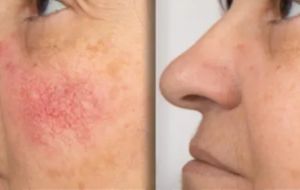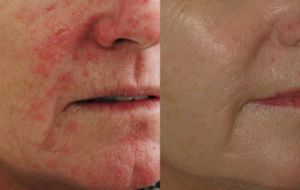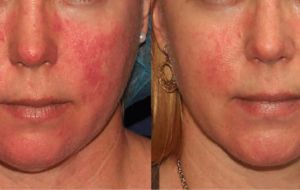Rosacea is a common and chronic skin condition that primarily affects the facial area, resulting in redness, visible blood vessels, and the development of small, pus-filled bumps. It often presents in a way that resembles a perpetual blush and can be accompanied by a burning or stinging sensation. It can be both physically uncomfortable and emotionally distressing, impacting one’s self-esteem and quality of life. The main underlying cause of rosacea is still unknown. But there are few associated trigger factors of the same.
Book Your Appointment
Book Your Appointment

What is Rosacea?

Causes of Rosacea
● Vascular and inflammatory factors: Abnormalities in blood vessels and heightened inflammatory responses within the skin are believed to contribute to rosacea.
● Genetic predisposition: A family history of rosacea can increase the likelihood of developing the condition.
● Triggers: Certain factors like sun exposure, alcohol, spicy foods, and temperature extremes can trigger or worsen rosacea symptoms. Hot humid environments like the kitchen, getting emotional or crying, use of certain cosmetic products and improper lifestyle are a few more to add on.

Signs of Rosacea
● Facial redness: Persistent redness, often in the central face, is a hallmark of rosacea. It can resemble a flush or sunburn.
● Visible blood vessels: Small, visible blood vessels (telangiectasia) become prominent, appearing as fine, red lines on the skin.
● Pimple-like bumps: Rosacea can lead to the development of papules and pustules, which are small, red, and pus-filled.

Types of Rosaces
● Erythematotelangiectatic Rosacea (ETR): This is commonly known as vascular rosacea which is characterized by redness of face, flushing, and blood vessel appearance.
● Papulopustular Rosacea (Inflammatory Rosacea): Here redness and swelling are accompanied by severe breakouts called papules and pustules.
● Rhinophyma (Phytamous Rosaces): This happens on or near the nose where the skin thickens and usually has a raised texture. It leads to an enlarged nose which appears swollen, and bulb shaped.
● Ocular Rosacea: Some people can feel grittiness in the eyes, and have dry, irritated, or swollen eyes. Eyelids can appear bumpy and red as a result of broken blood vessels.

Treatments for Rosacea at Dr. Haror's Wellness
At Dr. Haror’s Wellness, we offer comprehensive treatments to manage and alleviate rosacea symptoms. Our treatment options include:
● Topical creams and gels: These can help reduce redness and inflammation by constricting blood vessels as these are anti-inflammatory ointments.
● Oral medications: In some cases, oral antibiotics or anti-inflammatory drugs may be prescribed to control rosacea flare-ups.
● Intense pulsed light laser or Advanced Fluorescent laser therapy: Light-based machines are used to work on a certain defined wavelength which helps reduce redness and skin bumps. These treatments can target visible blood vessels and reduce redness.
● Lifestyle adjustments: We provide guidance on managing triggers and adopting a skincare routine that is gentle on sensitive skin.
Rosacea triggers can be different for different people, At Dr. Haror’s Wellness Centre, our expert doctors develop tailored treatment plans and lifestyle regimen that help patients get the optimum outcome.

Other Services Offered
Explore the diverse spectrum of services at Dr. Haror’s Wellness, where we specialize in crafting personalized experiences to cater to your individual requirements. Your transformative journey towards a ‘new you’ starts here!

Expertise personified:
Meet the Guru
Founded and led by Dr. Navnit Haror, a pioneer in aesthetic medicine. He is a dermatologist and a true expert in the art of skincare, widely recognized as a practitioner and expert in Aesthetic Surgery.
Guided by an unwavering commitment to enhancing skin vitality, Dr. Haror's expertise stands out in the innovative realm of Rosacea Treatment, a method that has gained global acclaim. Employing cutting-edge techniques and top-quality resources, he delivers a transformative journey, bestowing individuals with rejuvenated confidence. Backed by meticulous accuracy and a profound understanding of skin physiology, Dr. Haror customises each Rosacea Treatment to specific requirements, establishing a fresh benchmark for remarkable outcomes.
Dr. Navnit Haror
Gold Medalist | Dermatologist| Hair Transplant Surgeon

Our Doctors
We are founded, managed, and led by one of the world’s finest Aesthetic Surgeons, Dr. Navnit Haror and Dr. Vineeta Pathak.

Dr. Navnit Haror
Gold Medalist | Dermatologist| Hair Transplant Surgeon
Internationally acknowledged as a domain expert and practitioner of Aesthetic Surgery, Dr. Navnit Haror is a Dermatologist and Hair Transplant surgeon in practice since 2012 and is the Founder-Director of Dr. Haror’s Wellness. He has trained over 12,000 clinicians and doctors in hair transplantation techniques across 17 countries.

Dr. Vineeta Pathak
Consultant Cosmetologist | Hair Transplant & Aesthetic Surgeon
An award-winning dermatologist, Dr. Vineeta Pathak specializes in cosmetic dermatology and all aesthetic procedures. Her expertise includes vitiligo surgeries and ear lobe reconstruction, permanent hair reduction, hair transplants, lasers, and all aesthetic procedures among others.

FAQs
Empower yourself with knowledge and make informed decisions as you find answers to commonly asked questions about our services
How does Rosacea Treatment work?
It involves various methods that work to exfoliate the skin, stimulate collagen production, and promote overall skin renewal.
How many sessions are usually needed?
The number of sessions required for noticeable results can vary depending on individual skin conditions and the specific treatment method used.
Is there any downtime associated with this treatment?
The downtime can vary depending on the intensity of the treatment. Some methods might cause minimal redness or peeling, which usually subsides within a few days.
Are the results permanent?
While it can provide long-lasting improvements, the results are not always permanent.
Is Rosacea Treatment painful?
Most Rosacea Treatment methods are minimally uncomfortable and well-tolerated.





